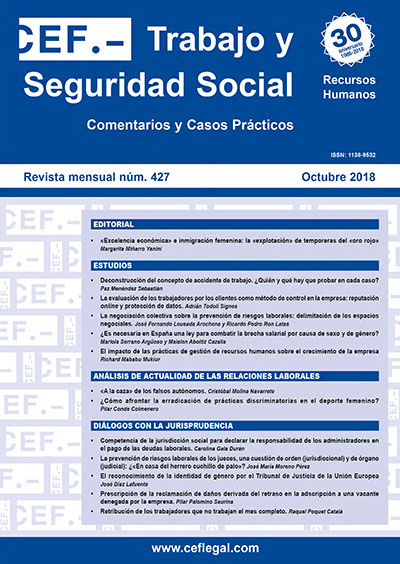Análisis empírico del impacto de las prácticas de gestión estratégica de recursos humanos sobre el crecimiento de la empresa
DOI:
https://doi.org/10.51302/rtss.2018.1512Palabras clave:
gestión estratégica de recursos humanos, crecimiento de empresa, innovación, gestión de conocimientoResumen
Accésit Premio «Estudios Financieros» 2018
El presente estudio analiza la relación existente entre las prácticas de gestión estratégica de recursos humanos, la innovación, la gestión de conocimiento y el crecimiento de la empresa. En este sentido, el propósito del estudio ha sido el análisis del impacto de las prácticas de dirección y gestión estratégica de recursos humanos sobre el crecimiento de la empresa, así como los efectos mediadores de la innovación organizacional y la gestión de conocimiento. Para alcanzar este objetivo, se administraron diferentes escalas o instrumentos a 460 participantes que trabajan en una empresa del sector de telecomunicaciones. El análisis de regresión múltiple jerárquica y las correlaciones de Pearson han sido las principales técnicas utilizadas para el análisis de datos. Los resultados obtenidos presentan e identifican las correlaciones altamente significativas entre las prácticas de gestión estratégica de recursos humanos y el crecimiento empresarial percibido (subjetivo) y el crecimiento empresarial real (objetivo). Asimismo, las prácticas de recursos se perfilan como buenos predictores del crecimiento empresarial. Por otra parte, se destaca que la innovación y gestión de conocimiento tienen efectos de mediadores en la relación entre las prácticas de gestión estratégica de recursos humanos y el crecimiento empresarial. Por último, se proponen algunas implicaciones prácticas y futuras líneas de investigación.
Descargas
Citas
Agarwala, T. (2003). Innovative human resource practices and organizational commitment: an empirical investigation. International Journal of Human Resource Management, 14(2), 175-197.
Armstrong, M. (2006). A Handbook of Human Resource Management Practice. London: Kogan Page.
Arthur, J. (1994). Link between business strategy and industrial relations systems in African steel mills. Industrial and Labour Relations Review, 45(4), 488-506.
Barringer, B. R., Jones, F. F. y Neubaum, D. O. (2005). A quantitative content analysis of the characteristics of rapid-growth firms and their founders. Journal of Business Venturing, 20, 663-687.
Cardon, M. S. y Stevens, C. E. (2004). Managing human resources in small organizations: What do we know? Human Resource Management Review, 14, 295-323.
Collins C. J. y Clark, K. D. (2003). Strategic human resource practices, top management commitment, team social networks and firm performance: the role of human resource practices in creating organizational competitive advantage. Academy of Management Journal, 46(6), 740-751.
Damanpour, F., Szabat, K. A. y Evan, W. M. (1989). The relationship between types of innovation and organizational performance. Journal of Management Studies, 26(6), 587-601.
Damanpour, F. y Gopalakrishnan, S. (1998). Theories of organizational structure and innovation adoption: the role of environmental change. Journal of Engineering and Technology Management, 15, 1-24.
Darroch, J. y McNaughton, R. (2002). Examining the link between knowledge management practice and types of innovation. Journal of Intellectual Capital, 3(3), 210-222.
Deema T. A. y Jabur, A. (2018). Development and validation of a knowledge management questionnaire. Journal of Information Studies & Technology, 2-18.
Farouk, S., Abu, H., Obeidat, M. y Al-Nahyan, M. (2016). HRM practices and organizational performance in the UAE banking sector. The mediating role of organizational innovation. International Journal of Productivity and Performance Management, 65(6), 773-791.
Gill, C. (2018). Don't know, don't care: An exploration of evidence based knowledge and practice in human resource management. Human Resource Management Review, 28(2), 103-115.
Gunday, G., Ulusoy, G., Kilic, K. y Alpkan, L. (2011). Effects of innovation types on firm performance. International Journal of Production Economics, 133(2), 662-676.
Huselid, M. A. (1995). The impact of human resource management practices on turnover, productivity and corporate financial performance. Academy of Management Journal, 38(3), 635-672.
James, L. R., Demaree, R. G. y Wolf, G. (1984). Estimating within-group interrater reliabilitywith and without response bias. Journal of Applied Psychology, 69(1), 85-98.
Jiménez-Jiménez, J. y Sanz-Valle, R. (2005). Innovation and human resource management fit: an empirical study. International Journal of Manpower, 26(4), 364-381.
Li, Y., Zhao, Y. y Liu, Y. (2006). The relationship between HRM, technology innovation and performance in China. International Journal of Manpower, 27(7), 679-697.
Meena, K. y Vanka, S. (2017). Developing an empirical typology of diversity-oriented human resource management practices. Journal of Management Development, 36(7), 915-929.
Morishima, M. (1991). Information sharing and firm performance in Japan. Industrial Relations, 30(1), 37-61.
Nieves, J. y Quintana, A. (2018). Human resource practices and innovation in the hotel industry: The mediating role of human capital. Tourism and Hospitality Research, 18(18), 72-83.
OECD (2005). Oslo Manual: Proposed Guidelines for Collecting and Interpreting Technological Innovation Data. Paris: OECD.
Pfeffer, J. (1998). Seven practices of successful organizations. California Management Review, 40(2), 96-124.
Rønde, T. (2001). Trade secrets and information sharing. Journal of Economics & Management Strategy, 10(3), 391-417.
Schuler, R. S., Jackson, S. E. y Storey, J. (2001). Human Resources Management and its link with strategic management. En J. Storey (Ed.), Human Resource Management: A Critical Text (pp. 114-130). London: Thomson Learning.
Senge, P. M. (1992). La quinta disciplina. El arte y la práctica de la organización abierta al aprendizaje. Barcelona: Granica.
Seunghoo, L., Tae, W. y Soo-Young, L. (2017). Shedding new light on strategic human resource management: the impact of human resource management practices and human resources on the perception of Federal Agency Mission Accomplishment. Public Personnel Management, 46(2), 91-117.
Shipton, H., Fay, D., West, M., Patterson, M. y Birdi, K. (2005). Managing people to promote innovation. Creativity and Innovative Management, 14(2), 118-128.
Truss, C. (2001). Complexities and controversies in linking HRM with organizational outcomes. Journal of Management Studies, 38(8), 1.121-1.149.
Vermeeren, B. (2017). Influencing public sector performance: studying the impact of ability, motivation and opportunity-enhancing human resources practices on various performance outcomes in the public sector. International Review of Administrative Sciences, 83(4), 717-737.
Wimbush, J. C. (2005). Spotlight on human resource management. Business Horizons, 48, 463-467.
Wright, P. M. y McMahan, G. C. (1992). Theoretical perspectives for strategic human resource management. Journal of Management, 18, 295-320.



















